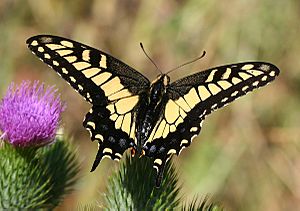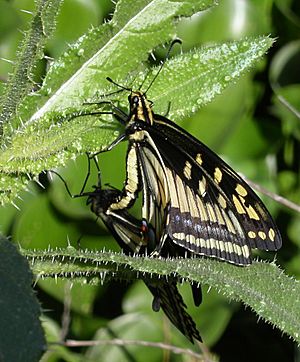Anise swallowtail facts for kids
Quick facts for kids Anise swallowtail |
|
|---|---|
 |
|
| Conservation status | |
| Scientific classification | |
| Genus: |
Papilio
|
| Species: |
zelicaon
|
The anise swallowtail (Papilio zelicaon) is a common and beautiful butterfly. You can find it in western North America. This butterfly has mostly black wings. But, a wide yellow stripe crosses its upper wings. This makes the butterfly look mostly yellow. Its back wings also have bright blue spots on the edges. Like other swallowtails, it has small "tails" on its hindwings.
This butterfly's wings can spread from 52 to 80 mm (2.0 to 3.1 in). Its body is a bit shorter than the Western tiger swallowtail. The western tiger swallowtail is a similar butterfly that lives in the same areas. The anise swallowtail also does not have the black stripes that go towards the tail, which the tiger swallowtail has. There is a rarer, darker type of anise swallowtail called P. z. nitra.
What Does It Look Like?
The anise swallowtail has a wingspan of about 52 to 80 millimeters (2 to 3.15 inches). Its wings are mostly yellow. They have black bands along the edges of both the front and back wings.
You can tell them apart from tiger swallowtail butterflies. Anise swallowtails are smaller. They also do not have the vertical black stripes that tiger swallowtails do. Near the tails of each wing, there are yellowish-orange to red spots. These spots look a bit like eyes and each has a black center. The butterfly's body is mostly black. It has yellow stripes running along its sides.
Where Does It Live?
The anise swallowtail butterfly likes open spaces. You will most likely see it on bare hills or mountains. It also lives in fields or along roadsides. You can often spot them in towns, in gardens, or empty lots.
This butterfly's usual home stretches from British Columbia and North Dakota in the north. It goes south to the Baja California Peninsula and other parts of Mexico.
Sometimes, people report seeing them in the southeastern United States. But their normal home does not go east of New Mexico. In the colder, northern parts of its range, the chrysalis (pupa) sleeps through the winter.
Life Cycle
Adult female butterflies lay their eggs one by one. They place them on the underside of host plant leaves. When the caterpillar first hatches, it is dark brown, almost black. It has a white band in the middle.
As the caterpillar grows, it sheds its skin. With each shed, it becomes greener. By its last stage, it is mostly green. It has black, orange, and light blue markings. Its main food plants are from the carrot family, like fennel. They also eat some plants from the citrus family.
If a swallowtail caterpillar feels threatened, it has a special defense. It will quickly push out bright orange "stinkhorns" from behind its head. These are called osmeteria. They are special glands that give off a bad smell to scare away predators. The caterpillar grows to about 5 centimeters (2 inches) long. Then, it forms a chrysalis. The chrysalis is either brown or green and about 3 centimeters (1.2 inches) long.
The anise swallowtail pupa (chrysalis) looks like a small branch. It sticks out slightly from the host plant. Strong silk holds it in place. This is where the adult butterfly will later emerge.
Images for kids





